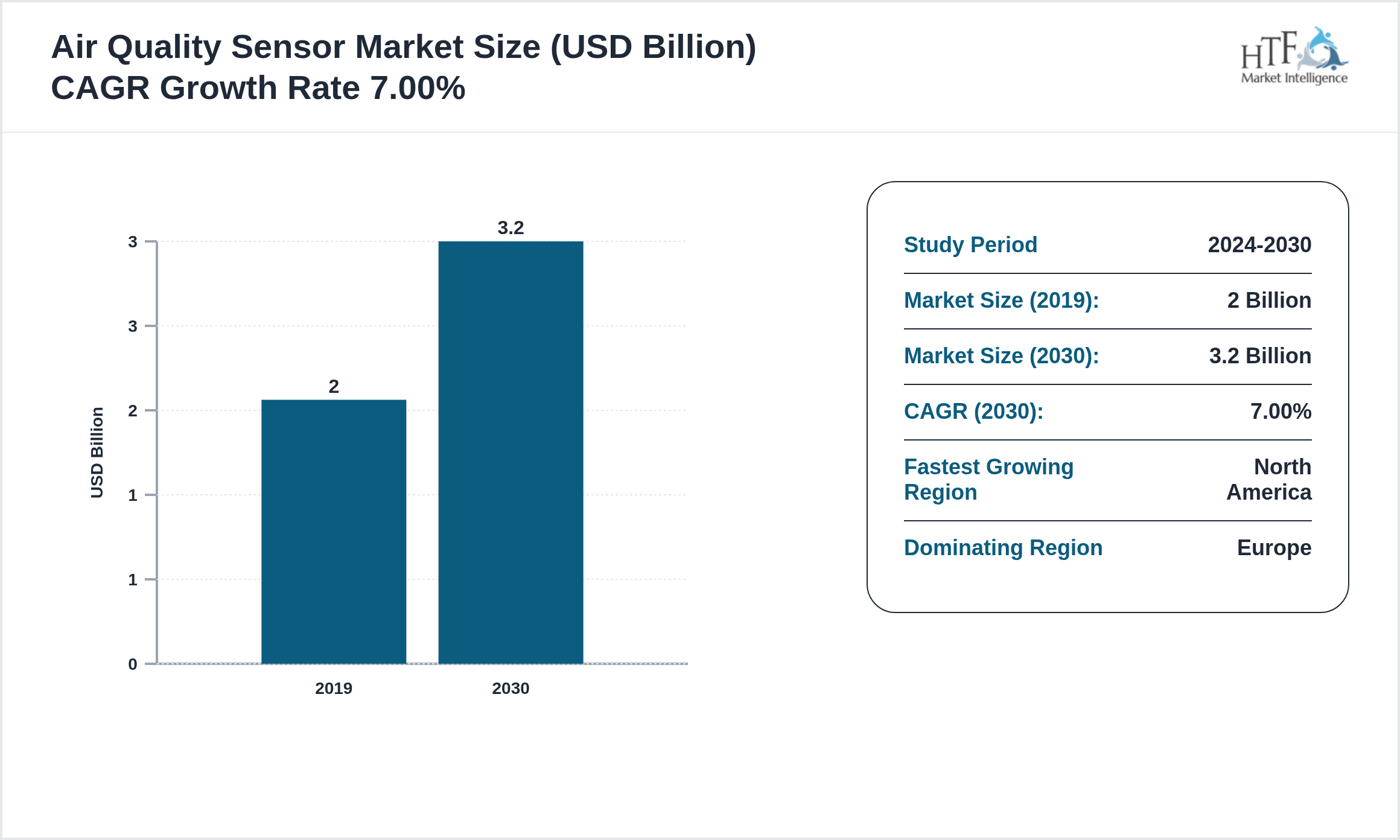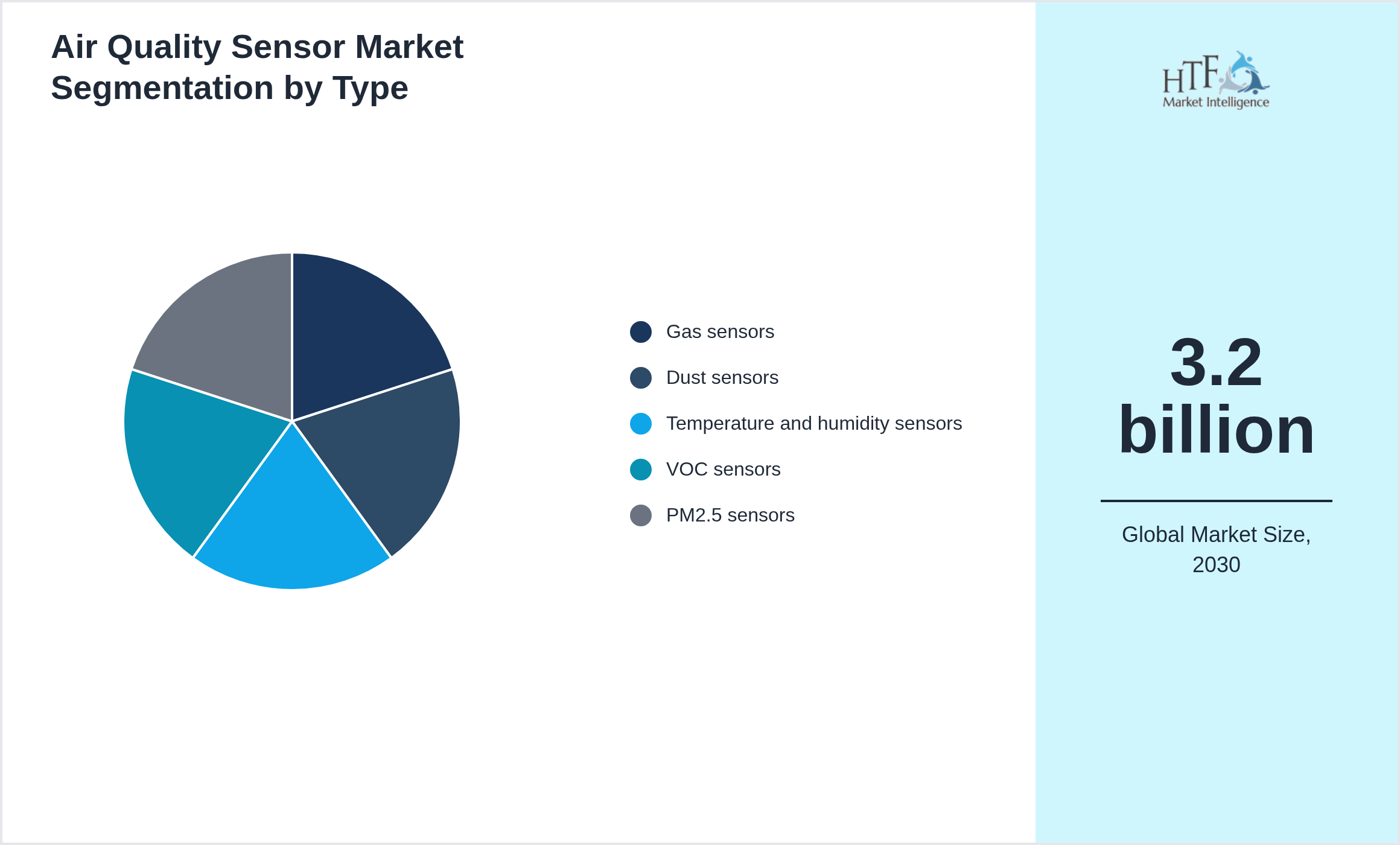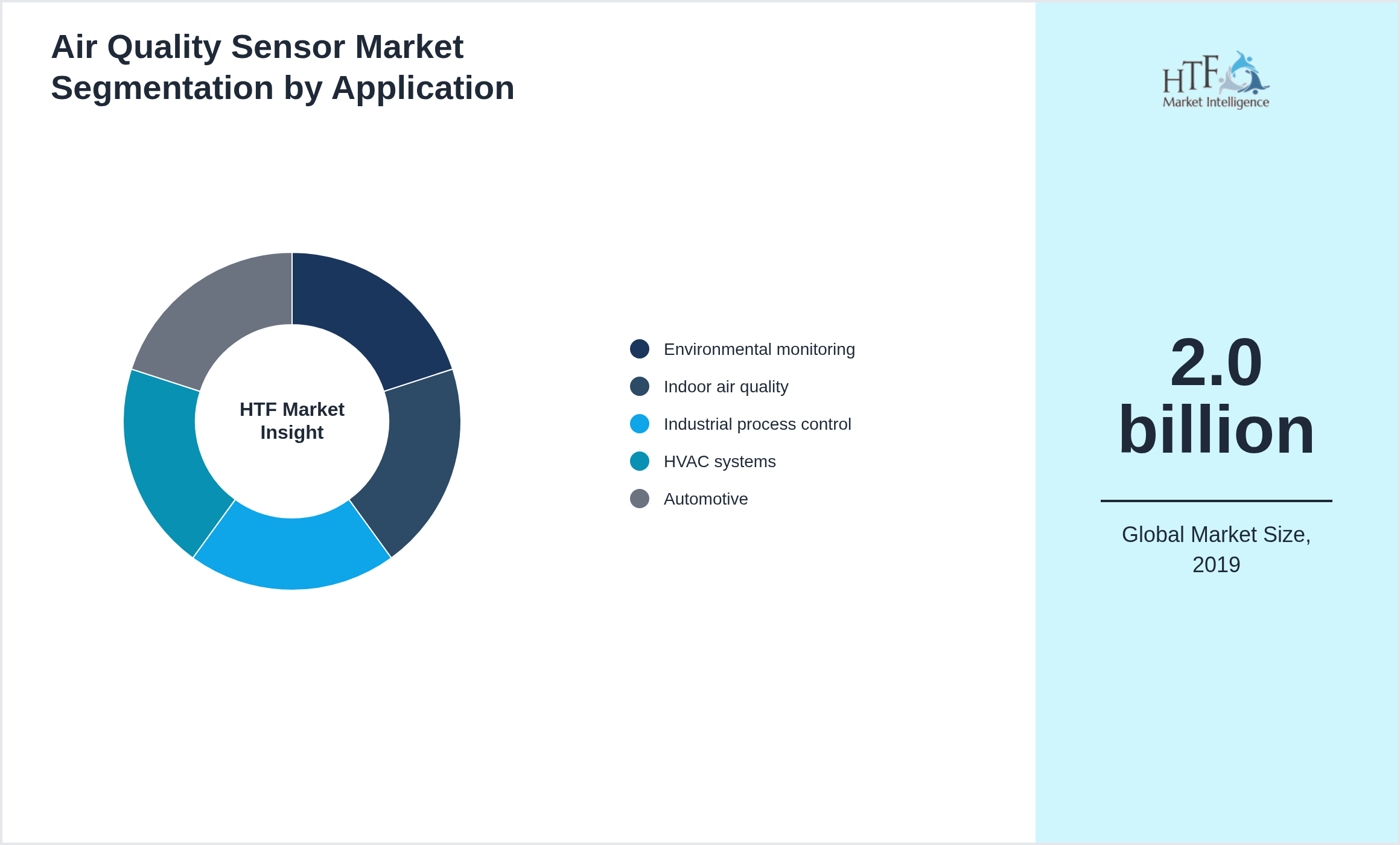Air Quality Sensor Market Research Report
Air Quality Sensor Market - Global Size & Outlook 2024-2030
Global Air Quality Sensor Market is segmented by Application (Environmental monitoring, Indoor air quality, Industrial process control, HVAC systems, Automotive), Type (Gas sensors, Dust sensors, Temperature and humidity sensors, VOC sensors, PM2.5 sensors), and Geography (North America, LATAM, West Europe, Central & Eastern Europe, Northern Europe, Southern Europe, East Asia, Southeast Asia, South Asia, Central Asia, Oceania, MEA)
Pricing
Industry Overview
According to the HTF Market Report, the Air Quality Sensor market is expected to see a growth of 7.00% and may reach a market size of 3.2 billion by 2030, currently valued at 2.0 billion.

The air quality sensor market focuses on devices that monitor and measure the quality of the air in terms of pollutants, particulate matter, and gases such as CO2, NOx, and VOCs. These sensors are crucial for monitoring air pollution in urban areas, industrial facilities, and indoor environments. The market is driven by the growing awareness of air pollution's impact on health, as well as stricter environmental regulations globally. Air quality sensors are used in residential, commercial, and industrial applications to improve air quality and ensure regulatory compliance. With the increasing demand for smart cities and IoT-connected devices, the air quality sensor market is expected to experience significant growth, spurred by technological advancements in sensor accuracy and affordability.
The chemical industry is a building block of the world's economy, driving innovation in sectors like pharmaceuticals and agriculture. It covers the production of base materials, including chemicals, polymers, and specialty compounds, integral to practically all products and processes. Companies in this sector are primary actors in supply chains, ensuring raw materials for manufacturing, construction, and consumer goods. With a focus on sustainability, the industry is increasingly investing in green chemistry and circular economy initiatives to reduce environmental impact. This industry will continue to grow with technological advancements, regulatory compliance, and market demand for more sustainable and innovative solutions; hence, it is energetic and a significant contributor in the business arena.
Key Player Analysis
The key players in the Air Quality Sensor are intensifying their focus on research and development (R&D) activities to innovate and stay competitive. Major companies, such as Aeroqual, AeroVironment, Siemens, Honeywell, Bosch are heavily investing in R&D to develop new products and improve existing ones. This strategic emphasis on innovation is driving significant advancements in product formulation and the introduction of sustainable and eco-friendly products.
Additionally, these industry leaders are actively acquiring smaller companies to broaden their regional presence and strengthen their market share. These acquisitions not only diversify product portfolios but also provide access to new technologies and markets, fostering growth within the Air Quality Sensor through operational streamlining and cost reduction.
Moreover, there is a clear shift toward green investments, with companies allocating more resources to sustainable practices and the development of environmentally friendly products. This response to increasing consumer demand for sustainable solutions and stricter environmental regulations positions these companies as leaders in green chemistry, further driving market growth.
The companies highlighted in this profile were selected based on insights from primary experts and an evaluation of their market penetration, product offerings, and geographical reach. We also include recent years' innovation and strategies followed by companies who are growing in the market:
- • Aeroqual
- • AeroVironment
- • Siemens
- • Honeywell
- • Bosch
Regional Insights
The chemical industry exhibits significant regional variation, driven by factors such as resource availability, regulatory environments, and economic conditions. In North America, the industry is maintained by abundant natural resources, particularly shale gas, which provides a competitive advantage in petrochemical production. The U.S. remains a key player, with ongoing investments in advanced manufacturing technologies and sustainable practices positioning the region as a leader in innovation.
In Europe, stringent environmental regulations and a strong emphasis on sustainability are shaping the chemical industry. The European Green Deal is pushing companies toward greener production methods, fostering growth in bio-based chemicals and recycling initiatives. Despite these opportunities, the region faces challenges from high energy costs and regulatory pressures, which are driving companies to seek efficiencies and explore new markets.
Asia-Pacific is the fastest-growing region, fuelled by rapid industrialization, urbanization, and a growing middle class. China dominates the regional market, supported by substantial investments in infrastructure and innovation. India and Southeast Asia are also emerging as key players, with increasing demand for chemicals in agriculture, construction, and electronics sectors.
Overall, regional dynamics in the chemical industry are shaped by local market conditions, regulatory landscapes, and the global push for sustainability, leading to diverse growth opportunities across different markets.
This report also splits the market by region
- North America
- LATAM
- West Europe
- Central & Eastern Europe
- Northern Europe
- Southern Europe
- East Asia
- Southeast Asia
- South Asia
- Central Asia
- Oceania
- MEA
Market Segmentation
Segmentation by Type
- • Gas sensors
- • Dust sensors
- • Temperature and humidity sensors
- • VOC sensors
- • PM2.5 sensors

Segmentation by Application
- • Environmental monitoring
- • Indoor air quality
- • Industrial process control
- • HVAC systems
- • Automotive

Regulatory Overview
The chemical industry is based on a regulatory framework that makes sure the industry does not harm the people, or the environment, or breach international standards. These regulations run from production to handling, storage, and disposal. The key legislations generally include the EU's REACH system and the US TSCA, which have also put stringent testing, reporting, and labeling requirements for chemical substances. Compliance with the above legislation requires that companies implement good safety management systems, conduct periodic audits, and monitor environmental performance continually. Apart from that, industry players also have to be abreast of changing legislation and newly emerging global standards on hazardous substances, waste management, and sustainability undertakings. Non-compliance can lead to substantial penalties, reputational damage, and operational discontinuations, which make adherence a key business issue.
Market Growth Drivers:
The Air Quality Sensor Market is experiencing significant growth due to various factors.
- • Emerging markets
- • Niche applications
- • Customization
Influencing Trend:
The Air Quality Sensor Market is growing rapidly due to various factors.
- • Accurate measurement
- • Real-time monitoring
- • Compact design
- • Low power consumption
- • Remote monitoring
Opportunities:
The Air Quality Sensor has several opportunities, particularly in developing countries where industrialization is growing.
- • Emerging markets
- • Niche applications
- • Customization
Challenges:
The market for fluid power systems faces several obstacles despite its promising growth possibilities.
- • High initial cost
- • Maintenance requirements
- • Calibration requirements
- • Technical expertise
- • Environmental factors
Report Infographics:
Report Features
|
Details
|
Base Year
|
2019
|
Based Year Market Size
|
2.0 billion
|
Historical Period
|
2024
|
CAGR (2019 to 2030)
|
7.00%
|
Forecast Period
|
2030
|
Forecasted Period Market Size (2030)
|
3.2 billion
|
Scope of the Report
|
Gas sensors, Dust sensors, Temperature and humidity sensors, VOC sensors, PM2.5 sensors, Environmental monitoring, Indoor air quality, Industrial process control, HVAC systems, Automotive
|
Regions Covered
|
North America, Europe, Asia Pacific, Latin America, and MEA
|
Companies Covered
|
Aeroqual, AeroVironment, Siemens, Honeywell, Bosch
|
Customization Scope
|
15% Free Customization (For EG)
|
Delivery Format
|
PDF and Excel through Email
|
Report Coverage
The study on the Air Quality Sensor market provides a thorough examination of the sector. Important company profiles, new product releases, significant mergers, acquisitions, and collaborations, as well as the incidence of osteoarthritis in important nations, are also highlighted in the research.
Air Quality Sensor - Table of Contents
Chapter 1: Market Preface
Chapter 2: Strategic Overview
Chapter 3: Global Air Quality Sensor Market Business Environment & Changing Dynamics
Chapter 4: Global Air Quality Sensor Industry Factors Assessment
Chapter 5: Air Quality Sensor : Competition Benchmarking & Performance Evaluation
Chapter 6: Global Air Quality Sensor Market: Company Profiles
Chapter 7: Global Air Quality Sensor by Type & Application (2024-2030)
Chapter 8: North America Air Quality Sensor Market Breakdown by Country, Type & Application
Chapter 9: Europe Air Quality Sensor Market Breakdown by Country, Type & Application
Chapter 10: Asia Pacific Air Quality Sensor Market Breakdown by Country, Type & Application
Chapter 11: Latin America Air Quality Sensor Market Breakdown by Country, Type & Application
Chapter 12: Middle East & Africa Air Quality Sensor Market Breakdown by Country, Type & Application
Chapter 13: Research Finding and Conclusion
Frequently Asked Questions (FAQ):
The Compact Track Loaders market is projected to grow at a CAGR of 6.8% from 2025 to 2030, driven by increasing demand in construction and agricultural sectors.
North America currently leads the market with approximately 45% market share, followed by Europe at 28% and Asia-Pacific at 22%. The remaining regions account for 5% of the global market.
Key growth drivers include increasing construction activities, rising demand for versatile equipment in agriculture, technological advancements in track loader design, and growing preference for compact equipment in urban construction projects.
